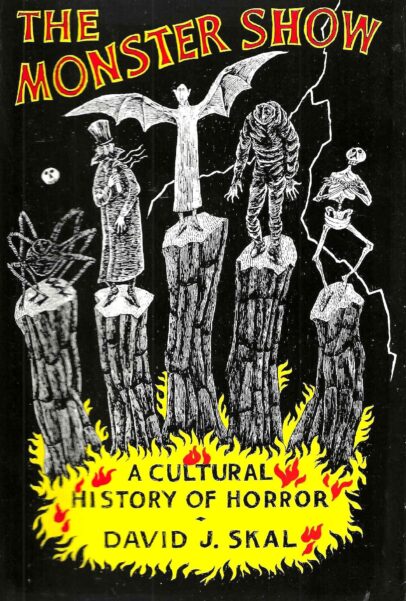 By DAVID J. SKAL (W.W. Norton; 1993)
By DAVID J. SKAL (W.W. Norton; 1993)
The first and best of David J. Skal’s “Cultural Histories.” That term, also used for Skal’s later book DEATH MAKES A HOLIDAY (about Halloween), denotes a quirky freeform treatment that won’t ever be mistaken for a scholarly analysis or academic treatise, and I say that’s a good thing. THE MONSTER SHOW’s subject, as the subtitle makes clear, is horror—20th Century horror, to be exact. That’s obviously a broad canvas that no 400 page book can hope to adequately cover (and indeed, a great deal of important info was left out—see below), but Skal’s erudite and imaginative treatment ensures a satisfying volume that’s as entertaining as it is informative.
Skal’s audacity is amply demonstrated in the introduction, which weaves in photographer Diane Arbus and Tod Browning, the director of DRACULA (1931) and FREAKS (1932), and this book’s major focal point. Skal would go on to co-author 1995’s DARK CARNIVAL, which remains the definitive Browning text, and his obsession with the man is amply showcased in THE MONSTER SHOW, which portrays Browning as a sort of infernal muse underlying the 20th Century. A controversial take, to be sure, but it’s hard to argue with Skal’s research.
Also covered are THE CABINET OF DR. CALIGARI, NOSFERATU, the Grand Guignol, Dr. Frederic Wertham, Vampira, gimmick-meister William Castle, FANGORIA magazine, Stephen King and AMERICAN PSYCHO, as well as some of the more obscure corners of the horrorscape. Included in that category are profiles of Horace Liveright, the flamboyant businessman who put on the stage versions of DRACULA and FRANKENSTEIN (from which the respective 1931 films were adapted); Arlene Francis, whose major contribution to the genre was being crucified and bled by Bela Lugosi in MURDERS IN THE RUE MORGUE (1932); and the disastrous CARRIE stage musical, whose particulars are lovingly detailed by Skal.
That Skal began his career as a novelist is evident in his many imaginative leaps and quirky observations. Foremost among the latter are his claims that “World War I found a persistent symbolic expression in horror entertainment, a tendency that never really ended,” “Most of the pubescent boys for whom the monster models were intended were no doubt conducting private, one-fisted physical experiments” and “Daytime talk shows (of the 1990s) had replaced the traditional sideshow tent.”
On the downside, important genre figures like H.P. Lovecraft, Roger Corman and Clive Barker are given only passing mentions, while Rod Serling, Richard Matheson, Dario Argento and Edward Gorey, whose art memorably graces this book’s cover, go MIA. Also given short shrift are subjects like folk horror (which to be fair wasn’t really a thing back in ‘93) and the late Twentieth Century intersection of horror and science fiction (an arena in which Skal himself thrived). So no, this is by no means a definitive study of Twentieth Century horror media, but it is a fun one.
